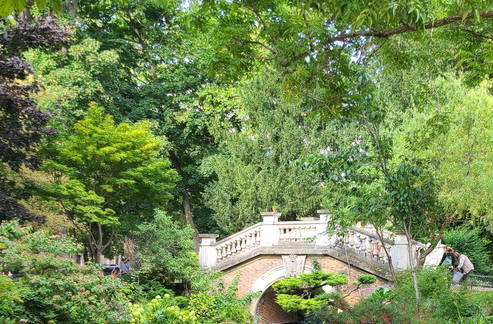Introduction
Begin: MiromesnilEnd: VilliersTime: Two to three hoursIntroductionYou will visit two hôtels particuliers (stand-alone homes) that were decorated by their wealthy owners in the late-nineteenth century (Jacquemart-André) and early-twentieth century (Nissim de Camondo). Both owners loved eighteenth-century art and decor and both had enough money to furnish their homes with masterpieces from the eighteenth century. On this walk, you will also visit one of Paris’s most beautiful parks, created in the eighteenth century.
#1 Musée Jacquemart-André
Begin at the Miromesnil métro stop. From the métro stop, take the avenue Percier exit. You will see a sign indicating the direction to the musée Jacquemart-André (avenue Percier to boulevard Haussmann). Turn left on boulevard Haussmann, cross the street, walk to Number 158, and go in the museum.The audio guide at the musée Jacquemart-André is very informative and will provide you with details about the Jacquemart-André (built between 1869 and 1875), and the art contained in it. Some of my favorites are the two oval-shaped paintings by François Boucher in the first room and Rembrandt’s Disciples at Emmaus in the bibliothèque. Be sure to notice the eighteenth-century furniture (mostly in the Louis XV style) and the amazing clocks and candelabras.
#2 boulevard Haussmann
Leave the museum and turn right down boulevard Haussmann.This boulevard is named after Baron Georges-Eugène Haussmann, the prefect of Paris from 1853 to 1870. Haussmann is largely responsible for the massive face lift Paris underwent during the second half of the nineteenth century. Most notably, he oversaw the layout of the bois de Boulogne, the construction of the Garnier Opéra, and the creation of the wide avenues and new, expensive buildings, which replaced small streets and run-down apartments.Continue down boulevard Haussmann. Look at most of the buildings on boulevard Haussmann: notice that they are six stories high (or seven by United States standards). The most expensive apartments were on the deuxième étage (second floor)—where there is usually the most intricate ironwork and balconies—and the least expensive were on the top floor (no elevators!).
#3 Parc Monceau
Turn right on rue de Courcelles and walk up to the Pagoda Paris, where you will turn right onto rue Rembrandt. This street will lead you into parc Monceau.The duke de Chartres purchased this property in 1769; parc Monceau subsequently evolved over the last part of the eighteenth century from a French garden to the English-style garden that it is today. Not generally frequented by many tourists, you will see, particularly in the summer, numerous local families playing and strolling through the park.
#4 Allée de la Comtesse de Ségur
Turn left and walk around the park.Notice that some of the buildings that border parc Monceau have higher floors than others—two stories in the same space as three in neighboring buildings. These buildings date from the seventeenth and eighteenth centuries while the others date from the nineteenth century. Speaking of age, not far to the left from where you entered the park, at the end of allée de la Comtesse de Ségur, there are some very old trees including an oriental sycamore that was planted in 1814, and at the far left-end of the park, a 100-foot tall maple tree that was planted in 1853.As you continue around the park, you will notice all sorts of ruins that were built as ruins (ruins were very popular in the late eighteenth and early nineteenth centuries): Egyptian, Greek, Gothic, Dutch, Chinese, etc. If you look hard enough, you might find a plaque celebrating the first ever parachute drop—André-Jacques Garnerin landed here after dropping over 3,000 feet from a hot air balloon in 1797.
#5 Musée Nissim de Camondo
Exit the park onto the avenue Velasquez. Turn right on boulevard Malesherbes and right again on rue de Monceau. After a very short walk, you will see the musée Nissim de Camondo on your right.This hôtel particulier is smaller than the Jacquemart-André but features amazing mirrors, clocks, tapestries, and porcelain. The musée Nissim de Camondo’s furniture is the most impressive of any museum in Paris. The New York Times called it “one of the finest collections anywhere of Continental furniture” (27 August 2006). As with the Jacquemart-André, this museum features a thorough audio guide.
The End
To return to the métro system, go back up rue de Monceau to rue de Miromesnil, turn left and you will find the Villiers métro stop one block up at boulevard de Courcelles.After the WalkIf you would like, return to the park to buy snacks, drinks, or crêpes.
